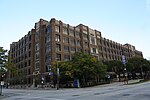Bradley Center

The Bradley Center (also known as the BMO Harris Bradley Center under sponsorship agreements) was a multi-purpose arena located on the northwest corner of North Vel R. Phillips Ave. and West State Streets in downtown Milwaukee, Wisconsin, United States. It was home to the Milwaukee Bucks of the NBA and the Marquette University men's basketball team. It was also the home of the Milwaukee Wave of the MISL, from 1988 to 2003, the original Milwaukee Mustangs of the AFL from 1994 to 2001, along with the second incarnation of the team from 2009 to 2012, the Badger Hockey Showdown from 1989 to 2002, and the Milwaukee Admirals of the AHL (and formerly of the IHL) from 1988 to 2016. The arena employed about 50 full-time employees, mostly tradespeople and about 700 part-time employees to help during events.Following the opening of the new Fiserv Forum in late August 2018, the Bradley Center was demolished to make way for future development. Assets from the arena, including display boards, scoreboards, equipment and sports and concert memorabilia were auctioned off.
Excerpt from the Wikipedia article Bradley Center (License: CC BY-SA 3.0, Authors, Images).Bradley Center
West State Street, Milwaukee
Geographical coordinates (GPS) Address Nearby Places Show on map
Geographical coordinates (GPS)
| Latitude | Longitude |
|---|---|
| N 43.043611111111 ° | E -87.916944444444 ° |
Address
West State Street 458
53203 Milwaukee
Wisconsin, United States
Open on Google Maps







